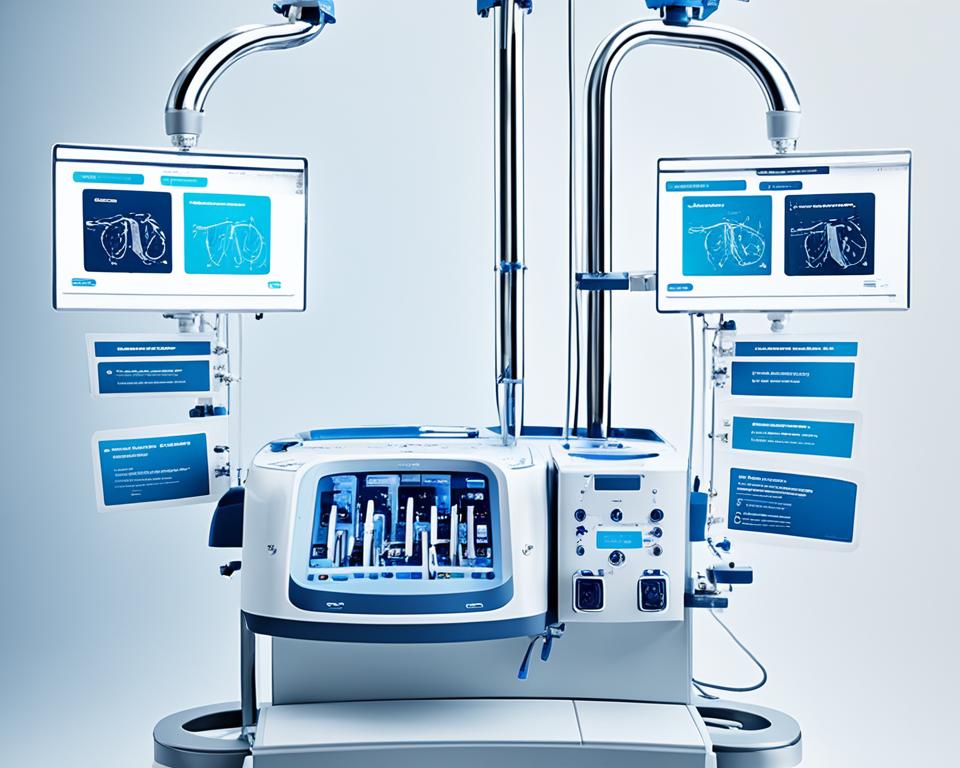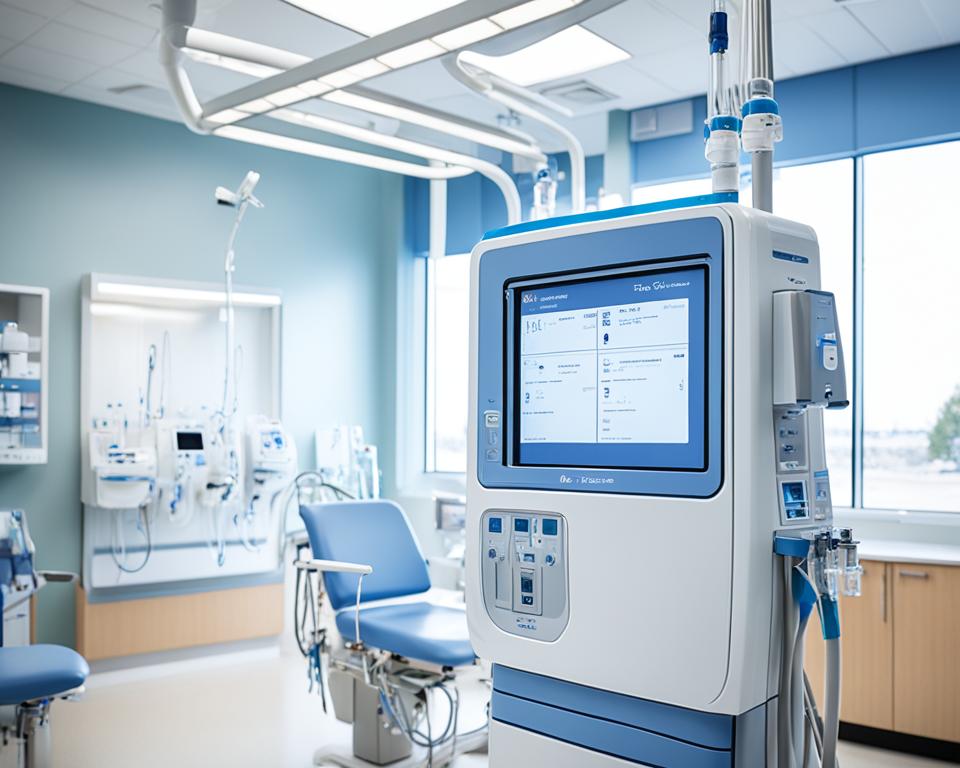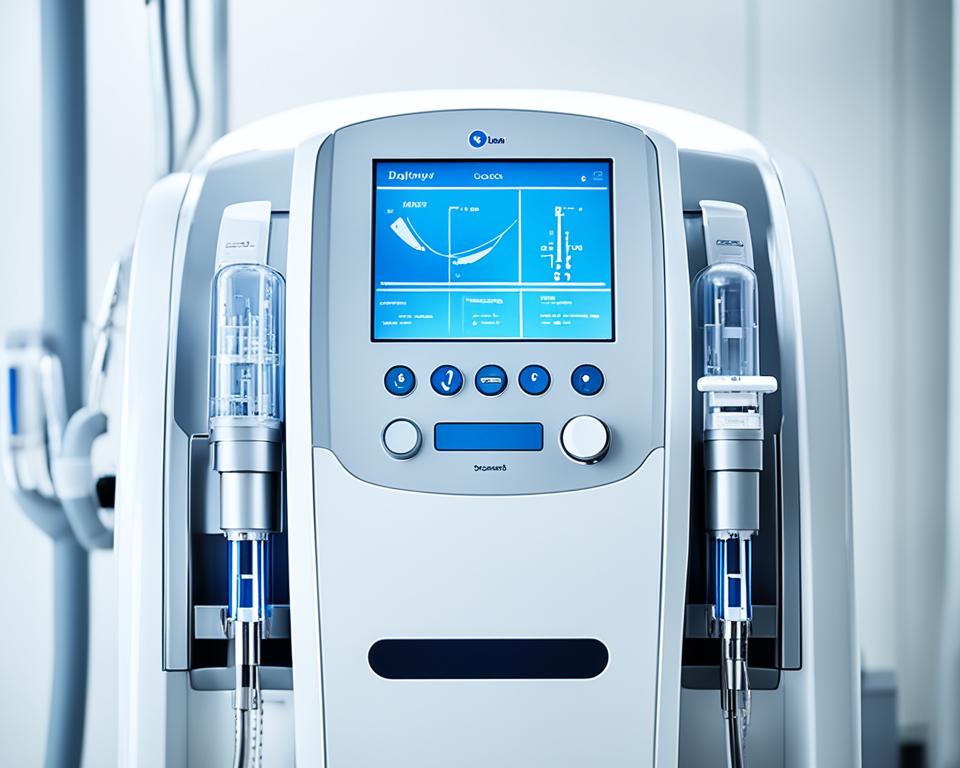Dialysis machines are vital in treating kidney disease, offering life-saving care for those with renal failure. However, their cost is a big worry for patients, healthcare workers, and institutions. This guide explores the dialysis machine cost in depth, helping you understand how to handle the costs of buying and keeping these crucial devices.
This guide will help you learn about the different types of dialysis machines, their purpose and functionality, and the average cost of hemodialysis and peritoneal dialysis machines. It also looks at the cost gaps between new and refurbished dialysis machines. Plus, it covers the prices of home dialysis units and dialysis equipment in clinics and hospitals.
Read interesting things at : trainwithnexus
Key Takeaways
- Dialysis machines are essential for managing kidney disease and renal failure.
- The cost of dialysis machines can vary significantly, depending on factors such as type, brand, and whether the machine is new or refurbished.
- Understanding the average cost of hemodialysis and peritoneal dialysis machines is crucial for budgeting and decision-making.
- Exploring cost-effective solutions, financing options, and the impact of technological advancements can help individuals and healthcare providers make informed choices.
- Factors like insurance coverage, maintenance, and selecting the right dialysis machine are also important considerations.
Understanding Dialysis Machines
Dialysis machines are key in the lives of those with kidney failure. They filter waste and extra water from the blood. This is what kidneys do when they’re working right.
Types of Dialysis Machines
There are two main kinds of dialysis machines: hemodialysis and peritoneal. Hemodialysis machines work like kidneys outside the body. They clean the blood and then put it back in the body. Peritoneal dialysis machines use the patient’s belly lining. They filter dialysis fluid in and out of the body.
Purpose and Functionality
Dialysis machines do the job of the kidneys. They take out waste and extra water, keeping the body’s fluids and minerals in balance. This is very important for health.
Dialysis machines are advanced. They have pumps, filters, monitors, and controls. These parts work together to measure blood and fluid flow. They also keep an eye on vital signs, making sure the treatment is just right.
Choosing the right dialysis machine for a patient depends on many things. This includes medical history and personal choices. Knowing about these machines is crucial for patients and doctors. It ensures the best treatment is given.
Factors Affecting Dialysis Machine Cost
The cost of dialysis machines can change a lot. This change depends on many things that affect the price. It’s key for patients, doctors, and others to know what these factors are as tech in healthcare gets better.
The main thing that makes dialysis machines cost more is how advanced they are. Machines with new tech, like better monitoring and automatic processes, cost more. Also, well-known brands that are known for being good and always improving their tech usually cost more.
How much it costs to keep the machine working is important too. Machines needing lots of fixes or special care over time cost more. This can raise the total cost for those who own them.
The place where you buy or use the machine matters for its price too. Things like how well the economy is doing in that area, taxes, and how much it costs to move the machine can change its price. Moreover, places where dialysis is more in demand or where fewer machines are available might have higher prices.
| Cost Factor | Impact on Dialysis Machine Pricing |
|---|---|
| Technological Advancements | Higher prices for more advanced features and capabilities |
| Brand Reputation | Premium pricing for well-established and trusted brands |
| Maintenance Requirements | Higher long-term costs for machines with frequent service needs |
| Geographical Location | Variations in pricing due to regional economic factors and market demand |
It’s very important to know about these factors affecting dialysis machine cost. It helps in making smart choices when buying and making sure patients get the best care while keeping costs in check.
“Dialysis machines are key in healthcare, so their cost shouldn’t be the only thing we think about. Looking at quality, how well it works, and if it will last long is important. We want to make sure patients get the best care.”
Average Cost of Dialysis Machines
Dialysis machines are essential for treating kidney failure but can be quite costly. It’s important to know the typical prices. This helps individuals and healthcare places plan their spending. We will look at average costs for hemodialysis and peritoneal dialysis machines.
Hemodialysis Machine Prices
Hemodialysis machines clean the blood and are usually more costly. A new one can cost from $10,000 to $30,000. The price changes based on brand, model, and features. These factors play a big role in the final cost.
If cost is a big concern, consider a refurbished machine. These have been checked and fixed. Refurbished hemodialysis machines might cost $5,000 to $15,000. They are much cheaper than new ones.
Peritoneal Dialysis Machine Prices
Peritoneal dialysis machines use the patient’s own body to filter waste. They are usually cheaper than hemodialysis machines. A new one could be $5,000 to $15,000. This makes them more affordable for use at home.
Refurbished peritoneal machines are also available for those who need to save money. They cost $2,500 to $10,000. But, it is crucial to get one that has been checked and is safe to use.
Choosing the right dialysis machine involves looking at many factors. Consider the machine’s features, performance, and upkeep costs. This way, you can find the best option for your situation.
Cost Breakdown: New vs. Refurbished Machines
Choosing between new and refurbished dialysis machines affects your spending. It’s vital to know the cost differences for both healthcare providers and patients.
Many prefer new machines for their modern tech and warranty. But they come with a high price tag. Refurbished machines, though, are cheaper, making them a good choice for budget-conscious buyers.
Exploring the Cost Differences
A new dialysis machine can cost between $25,000 to $50,000. A refurbished dialysis machine usually costs $10,000 to $25,000. This means a big drop, with a 50-70% savings.
Smaller healthcare centers, private practices, or those doing home dialysis benefit from these savings. They can then spend more on patient care and necessary staff training.
| Cost Comparison | New Dialysis Machine | Refurbished Dialysis Machine |
|---|---|---|
| Average Cost Range | $25,000 – $50,000 | $10,000 – $25,000 |
| Cost Savings | N/A | 50% – 70% |
Looking at a refurbished machine’s lower price is just the start. Make sure to also consider the costs of warranty, maintenance, and repairs. Thinking about these long-term costs helps you decide on the better buy.
How Much Dialysis Machine for Home Use
People needing regular dialysis must think about the price of a home dialysis machine. Going to a clinic for dialysis is effective. But having dialysis at home is more convenient and can improve life quality.
Portable Dialysis Unit Costs
Portable dialysis machines are now a popular choice for home treatment. They cost between $2,000 and $10,000. The price varies based on brand, technology, and the type of dialysis needed.
When looking at the cost, consider these points:
- Peritoneal dialysis machines cost less than hemodialysis ones.
- More features mean a higher price.
- Choosing a refurbished unit can save money and still work well.
It’s best to talk with health and insurance professionals. They can help you understand costs and payment coverage for home dialysis equipment.
“Dialyzing at home brings more freedom and independence. Yet, equipment expenses are a key factor to review.”
Researching prices and features of portable units helps. It lets users pick the right home dialysis for their needs at a good price.
Dialysis Machine Costs in Clinics and Hospitals
The price of a dialysis machine is only the start of the expenses. Clinics and hospitals face various costs for these life-saving devices. This includes the machine itself, its maintenance, and operating it.
Equipment and Maintenance Expenses
Machines in clinical or hospital settings are advanced compared to home models. They cost between $15,000 to $30,000, or more.
Installation and upkeep are extra costs. Regular maintenance is key and can be expensive. It involves changing filters and tubing, adding to yearly costs.
| Cost Category | Estimated Range |
|---|---|
| Dialysis Machine Purchase | $15,000 – $30,000+ |
| Installation and Setup | $1,000 – $5,000 |
| Annual Maintenance and Consumables | $2,000 – $10,000 |
| Ongoing Electricity and Water Usage | $1,000 – $3,000 per machine |
The costs don’t stop at the machine itself. There are ongoing charges like water and electricity. These costs can be significant, more so with many dialysis stations.
Healthcare providers need to plan and budget well. This is crucial to keep their dialysis programs running smoothly.
Cost-Effective Dialysis Solutions
Cost plays a big role in who can get dialysis treatment and how good their care is. But, there are many affordable solutions out there. These solutions range from using new technologies to help with the costs to finding different ways to pay for treatments. This part will show you how to make dialysis treatments easier to get and less expensive.
Innovative Dialysis Technologies
New dialysis technologies have made machines smaller, more efficient, and cheaper. Patients can now use dialysis units at home or on the go. This change means less money spent on clinics and helps patients take control of their treatment costs.
Affordable Dialysis Equipment Options
Besides new technology, there are cost-effective dialysis equipment options that don’t cost as much. These include used machines that have been repaired. They work just as well as new ones. Exploring these choices can help patients and healthcare places get the care they need at a price they can manage.
| Dialysis Machine Type | Average Cost of New Unit | Average Cost of Refurbished Unit |
|---|---|---|
| Hemodialysis Machine | $20,000 – $50,000 | $10,000 – $30,000 |
| Peritoneal Dialysis Machine | $5,000 – $15,000 | $3,000 – $10,000 |
By looking into these cost-effective dialysis solutions and affordable dialysis equipment options, both patients and healthcare providers can find efficient ways to afford dialysis care.
“Affordable and accessible dialysis care is essential for improving patient outcomes and quality of life. These innovative solutions are helping to make that a reality.”
Financing Options for Dialysis Machines
Healthcare providers and patients often struggle to find the best way to pay for dialysis machines. Thankfully, there are many choices out there. Let’s look into the main two: leasing and buying dialysis equipment.
Leasing vs. Purchasing
Leasing is great for healthcare places as they don’t need to pay a lot upfront. This helps manage their money better. Leasing also includes maintenance and servicing, saving the facility more money.
Buying dialysis machines is better in the long run and you own the equipment. This means you control how it’s used and when it’s replaced. It’s best for places that do a lot of dialysis with the same machines over time.
| Leasing | Purchasing |
|---|---|
| Lower upfront investment | Long-term cost savings |
| Spread financial burden over time | Full control over equipment |
| Potential maintenance and service included | Ownership benefits |
It’s key that healthcare providers think about their needs, budget, and long-term plans. Choosing between leasing and buying depends on what works best for each facility.
By looking at all the financing options available, healthcare groups can make choices that mix saving money with providing good dialysis care.
Impact of Technology Advancements
In recent years, the dialysis industry has seen big changes, thanks to new medical technology. These changes have made dialysis machines cheaper and more available, helping more patients.
Technology has cut the costs of dialysis machines in several ways. For instance, new dialysis technologies like improved filtration systems, more efficient pumps, and advanced sensors have been key. These upgrades make machines work better, last longer, and cost less to buy. Because of this, the impact of technology advancements on dialysis machine costs has meant lower prices and more access for people who need them.
Also, the introduction of portable and home-based dialysis units has made a big difference. These small, easy-to-use machines have grown popular because they’re portable. They also lessen the load on hospitals and care centers. The technology behind these portable machines has made them affordable, giving patients more options for doing dialysis at home.
Besides making machines cheaper, tech improvements have also boosted how well they work and cut repair needs. Tools like advanced diagnostics and predictive analytics help fix problems before they get big, saving money in the long run.
“The dialysis industry has witnessed a remarkable transformation in recent years, driven by the rapid advancements in medical technology.”
Looking ahead, tech’s role in lowering dialysis costs should keep growing. Explorations in AI, machine learning, and data analytics promise even more cost-effective and smarter solutions for patients.

Dialysis Machine Cost Analysis by Region
The cost of dialysis machines changes a lot depending on where you are. This is because different places have their own market conditions and healthcare rules. Knowing these differences is key for healthcare workers and patients. They want to make smart choices.
One big reason why dialysis machines vary in price is the level of healthcare in an area. Places with lots of advanced medical tech and good healthcare have more expensive machines. This is because they can buy the latest tech and have high-quality services. On the other hand, areas with fewer healthcare options might find cheaper machines. But, they might not have the latest features or support.
The rules also affect the cost. In some places, strict rules mean it’s harder for companies to sell their machines. This can make the machines cost more. But, in places where rules are clear and simple, the machines can be cheaper.
| Region | Average Hemodialysis Machine Price | Average Peritoneal Dialysis Machine Price |
|---|---|---|
| North America | $25,000 – $35,000 | $12,000 – $18,000 |
| Europe | $20,000 – $30,000 | $10,000 – $15,000 |
| Asia-Pacific | $15,000 – $25,000 | $8,000 – $12,000 |
| Latin America | $12,000 – $20,000 | $6,000 – $10,000 |
The table above shows you a rough idea of how much dialysis machines cost in different places. It points out the price gap for hemodialysis and peritoneal dialysis machines. Keep in mind, the actual price you pay could be different. It depends on many things like local market trends, government help, and the machine’s features.
Understanding the cost differences helps healthcare workers and patients make better choices. They can find solutions that are good for their area and wallet. This way, anyone who needs dialysis can get the care they deserve.
Insurance Coverage and Reimbursement
The cost of a dialysis machine is a big concern for many. This is for both individuals and places like hospitals and clinics. Luckily, there are insurance plans and programs that can help pay for these machines. It’s key to know about these insurance and reimbursement options if you need a dialysis machine.
Insurance Coverage for Dialysis Machines
Health insurance providers, including Medicare and Medicaid, often cover dialysis machines. This helps lower the costs for patients and healthcare places. How much they cover, including deductibles and co-pays, depends on the plan and the person’s situation.
Reimbursement for Dialysis Equipment
Aside from insurance, other programs help with the cost of dialysis machines. These programs, some by the government or non-profits, aim to assist financially. To receive aid, factors like income, machine type, and where you’re getting treatment are considered.
| Insurance Provider | Coverage for Dialysis Machines | Reimbursement Programs |
|---|---|---|
| Medicare | Covers a portion of the costs for dialysis machines and related equipment | Offers reimbursement for eligible individuals through the End-Stage Renal Disease (ESRD) program |
| Medicaid | Coverage varies by state, but often includes dialysis machine costs | Some states provide additional reimbursement options for dialysis equipment |
| Private Insurance | Coverage can vary significantly, with some plans offering partial or full coverage | Limited reimbursement options, typically handled on a case-by-case basis |
It’s crucial to research the insurance and reimbursement options available. This ensures you can get the necessary dialysis machine without a high cost.
By looking into these funding options, patients and healthcare places can work through the dialysis machine costs. This improves how easily people can get this important medical equipment, benefiting those in need.
Selecting the Right Dialysis Machine
Choosing the best dialysis machine is key for both patients and health workers. It involves looking at what the patient needs, the machine’s features, and how cost-effective it is. A good choice leads to better results for people undergoing dialysis.
Factors to Consider
There are several important points to think about when picking a dialysis machine:
- Patient Needs: Think about what the patient needs and likes. This includes their health, age, and how they live. The machine should meet these specific needs, providing a smooth and comfortable dialysis process.
- Device Capabilities: Look closely at what the machine can do. Consider its water system, how well it monitors the process, and how easy it is to use. It’s crucial that the device fits the patient’s condition and the doctor’s plan.
- Cost-Effectiveness: Compare the initial price of the machine with its upkeep costs. Think if it’s worth the money in the long run based on its quality and how well it helps the patient.
- Brand Reputation and Support: Check out the company’s reputation and its customer services. Pick a machine from a trusted brand that stands by its product with good maintenance and support.
- Regulatory Compliance: Be sure the machine follows all healthcare rules and is safe to use. This gives confidence that it’s a good, safe choice.
Thinking about these aspects helps in making a smart choice in dialysis machines. It ensures better care for patients while being mindful of costs and future needs.

“Finding the right dialysis machine is crucial for patient success. By looking at their needs and what the machine can do, healthcare providers can choose wisely. This means better care and happier patients.”
Dialysis Machine Maintenance and Servicing
Keeping dialysis machines in top shape is key to their long life and good work. They need regular care to stay running well. This reduces the long-term costs of keeping them up.
Maintaining a dialysis machine means doing many types of upkeep. You have to check and clean it often. Sometimes, you need to do harder repairs. This all keeps the machine from breaking and needing big fixes.
- Routine tasks include:
- Cleaning and making it germ-free
- Changing parts like filters and membranes when needed
- Getting sensors and monitors right
- Looking over the electrical and mechanical parts
- Every so often, the machine needs a deeper check-up. This is where qualified techs come in. They do:
- Big system checks to make sure everything’s working like it should
- Updates to the machine’s software and hardware
- Swapping out big parts, such as the pump or control system
The cost of maintaining dialysis equipment changes with the machine’s age and how much it’s used, as well as the care it gets. Newer machines might need less servicing because they can check themselves. But, older models might need more fixes, driving up costs.
“Proper maintenance and servicing are key to a dialysis machine’s long, dependable life, impacting the total cost of owning it.”
It’s vital for healthcare workers and patients to know about dialysis machine maintenance and servicing‘s value. Doing regular upkeep helps the machines last longer, work better, and be less pricey to keep in good shape over time.
Conclusion
In this detailed guide, we’ve delved into dialysis machine costs. We’ve looked at different types and what they’re for. And we’ve checked out what affects their prices.
We’ve discussed the money you might spend on hemodialysis and peritoneal machines. Also, we’ve talked about whether new or used units are better. This wealth of information is for healthcare pros and patients. It helps them deal with the many choices in dialysis equipment.
The key message here is about finding dialysis options that are easy on the budget. New technology has brought down costs. For example, there are now portable machines and new ways to pay for them.
We hope this guide helps you find cost-friendly, quality dialysis care. It’s about making important treatment available to everyone, no matter their budget. By using the info in this guide, we can aim for a future where all patients can get well.


